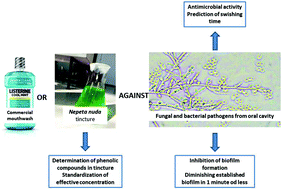Characterization of phenolic compounds in tincture of edible Nepeta nuda: development of antimicrobial mouthwash
Abstract
The activity of edible Nepeta nuda L. (Lamiaceae) tincture and Listerine towards a selected group of oral pathogenic microorganisms (4 bacterial and 9 fungal strains) has been explored. Their potentials to inhibit the formation of biofilm and to diminish established biofilm have been compared. The amount of N. nuda tincture and swishing time necessary for reaching better or equivalent antimicrobial effect than that of Listerine have been predicted. Phenolic compounds in N. nuda tincture are determined by LC-DAD/ESI-MSn. Both Listerine and N. nuda tincture possess good antimicrobial potentials (MIC in the range of 0.8–15 μL per well) including inhibition of biofilms. Rosmarinic acid and verminoside are the most dominant phenolic compounds present in the N. nuda tincture. Based on in vitro results, we infer that it is more desirable to swish 20 mL of mouthwashes (Listerine and N. nuda tincture, 100 mg mL−1) for 30 s when dealing with selected microorganisms in general and for 60 s (N. nuda tincture) when dealing with bacterial biofilms.



 Please wait while we load your content...
Please wait while we load your content...